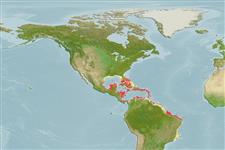>
Eupercaria/misc (Various families in series Eupercaria) >
Haemulidae (Grunts) > Haemulinae
Etymology: Haemulon: Greek, haimaleos = bloody (Ref. 45335).
More on author: Poey.
Environment: milieu / climate zone / depth range / distribution range
Ökologie
seewasser riff-verbunden; tiefenbereich 3 - 25 m (Ref. 9626). Subtropical; 33°N - 34°S, 98°W - 34°W
Western Atlantic: southern Florida (USA), Bahamas, and Yucatan, Mexico to Brazil; including the Gulf of Mexico and the entire Caribbean Sea (Ref. 9626).
Size / Gewicht / Alter
Maturity: Lm ? range ? - ? cm
Max length : 36.0 cm TL Männchen/unbestimmt; (Ref. 7251); common length : 20.0 cm TL Männchen/unbestimmt; (Ref. 3798)
Rückenflossenstacheln (insgesamt) : 12; Rückenflossenweichstrahlen (insgesamt) : 15 - 16; Afterflossenstacheln: 3; Afterflossenweichstrahlen: 8. Pale gray above; belly darker gray. Yellow stripes along side; bronze-yellow stripes and spots on head (Ref. 26938). Snout and fins primarily brownish (Ref. 13442).
Occurs in clear rocky or coral reefs (Ref. 5217) and mangroves (Ref. 26340). Often forming schools (Ref. 3798). Nocturnal feeder on crabs, gastropods, starfish and annelid worms (Ref. 5521). Marketed fresh (Ref. 3798).
Life cycle and mating behavior
Geschlechtsreife | Fortpflanzung | Ablaichen | Eier | Fecundity | Larven
Oviparous, distinct pairing during breeding (Ref. 205).
Cervigón, F., 1993. Los peces marinos de Venezuela. Volume 2. Fundación Científica Los Roques, Caracas,Venezuela. 497 p. (Ref. 9626)
IUCN Rote Liste Status (Ref. 130435: Version 2024-2)
Bedrohung für Menschen
Harmless
Nutzung durch Menschen
Fischereien: weniger kommerziell; Aquarium: Öffentliche Aquarien
Tools
Zusatzinformationen
Download XML
Internet Quellen
Estimates based on models
Preferred temperature (Ref.
123201): 26.3 - 28.2, mean 27.5 °C (based on 658 cells).
Phylogenetic diversity index (Ref.
82804): PD
50 = 0.5000 [Uniqueness, from 0.5 = low to 2.0 = high].
Bayesian length-weight: a=0.01622 (0.00910 - 0.02890), b=2.99 (2.84 - 3.14), in cm total length, based on LWR estimates for this species & Genus-body shape (Ref.
93245).
Trophic level (Ref.
69278): 3.7 ±0.2 se; based on diet studies.
Widerstandsfähigkeit (Ref.
120179): mittel, Verdopplung der Population dauert 1,4 - 4,4 Jahre. (Preliminary K or Fecundity.).
Fishing Vulnerability (Ref.
59153): Low to moderate vulnerability (26 of 100).
Nutrients (Ref.
124155): Calcium = 27.7 [9.4, 68.4] mg/100g; Iron = 0.569 [0.282, 1.083] mg/100g; Protein = 20.1 [18.2, 21.9] %; Omega3 = 0.2 [0.1, 0.4] g/100g; Selenium = 12.1 [5.9, 24.5] μg/100g; VitaminA = 55.8 [20.2, 164.9] μg/100g; Zinc = 0.784 [0.496, 1.273] mg/100g (wet weight);
